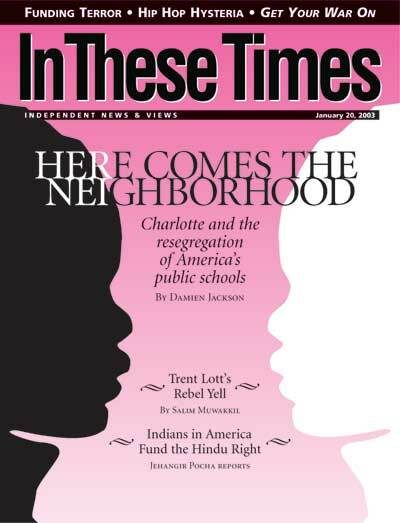In the past decade, a veritable Kindergulag has been erected around schoolchildren, making them subject to arbitrary curfews, physical searches, psychological profiling schemes and – in the latest institutionalized indignity – random, suspicion-less, warrant-less drug testing for just about any kid who wants to pursue extracurricular interests.
Last summer, the Supreme Court gave carte blanche to school districts that want to impose drug testing on kids who’ve cast suspicion upon themselves by volunteering for extracurricular activities. The 5-to-4 decision on June 27 upheld a drug-testing program in a Tecumseh County, Oklahoma, school district that requires students engaged in any “competitive” extracurricular activities to submit to random drug testing.
This isn’t just about keeping jocks from enjoying a post-practice beer or joint. The decision approves the testing of any student who volunteers for the Future Farmers of America, Future Homemakers of America, the cheerleading squad, the choir, the color guard or even those sacrosanct curators of Sousa, the marching band.
There is understandably a good deal of sympathy for drug testing as a social safety mechanism to catch kids who might be heading toward life-destroying drug abuse, social isolation and crime. Who doesn’t want to catch a kid before he takes a life-long fall? Yet before parents surrender their kids to the arms of the therapeutic enforcement state, they need to come to terms with the provenance of the interventions they are tacitly endorsing for their kids — and some of the more enduring shared consequences of drug testing.
Drug testing actually arrived in American schools by way of the armed forces and the prison system. The Navy began testing servicemen for drugs 30 years ago, when the first test kits were developed. By the late ’70s, prisoners were being subjected to urinalysis. By the mid-’80s, defense-related contractors were pressed to test their work forces for purity. In the final days of the Reagan administration, the Federal Drug Free Workplace Act forced drug testing on all federal contractors working on projects of any appreciable size. From there, against sporadic and fractured opposition by labor unions and civil liberties groups, urinalysis and drug-testing programs proliferated in almost every industry.
America’s kids are now being subjected to the kind of intrusions the nation would inflict only upon conscripts and criminals just 20 or 30 years ago. Who knows how much further it could go? The latest decision in Board of Education of Independent School District No. 92 v. Earls essentially opens the way for general random drug testing of America’s entire school population, says Timothy Lynch, director of the Criminal Justice Project at the Cato Institute in Washington.
The first movement toward urinalysis of the total student population was choreographed by the Supreme Court in 1995 with the Vernonia School District v. Acton case in Oregon. The court decided, among other things, that since athletes shower together, they have little expectation of privacy — and thus urinalysis of athletes was deemed constitutional.
In the case of Lindsay Earls — who was humiliated after being yanked out of choir practice by Tecumseh school administrators and ordered to urinate on command (she tested negative) — the Supreme Court justices appeared eager to extend the scope of drug testing. In oral arguments last March, Justice Anthony Kennedy taunted ACLU Attorney Graham Boyd, hypothesizing that his client would prefer to attend a “druggie” school.
Writing for the majority, Justice Clarence Thomas extended the relevance of the factors used to test “reasonableness” of a search in Vernonia to apply much more broadly, while enthroning the school district’s interest in detecting drug use. In a breathtaking act of militant jurisprudence and shabby reasoning, Justice Thomas quickly expanded the universe of candidates for urinalysis and established a new entitlement for the state to determine the suitability of testing beyond parental guidance — “custodial responsibilities,” he called it.
After the decision, scores of school districts immediately began inspecting the language of the decision and considering establishing their own urinalysis programs based on the Tecumseh model.
In the Lockney School District in West Texas, Superintendent Raymond Lusk told the New York Times in September, “We’ll probably get 85 percent of the kids in extracurriculars. I think it would be fairer to test everybody, because why are some kids more important than others?”
Touché. Now that there is a state entitlement to test at will, pressing the PC buttons that demand fairness in application of entitlements and social burdens will surely extend testing to all students.
The prognosis for the rest of us is just as grim. With the Supreme Court establishing that the state has a superseding interest in cultivating a therapeutic enforcement role that trumps even clear, constitutionally guaranteed freedoms, nothing should be ruled out of the realm of possibility. A drug test requirement when you renew your driver’s license? For filing a tax return? Before you vote?
Give it five years — or 50. Children are being acclimated to violations by the state that their grandparents would have found unconscionable. The future Supreme Court justices being conditioned in our schools today will no doubt chuckle in disbelief some day that on-demand urinalysis was ever an issue of legal contention.





